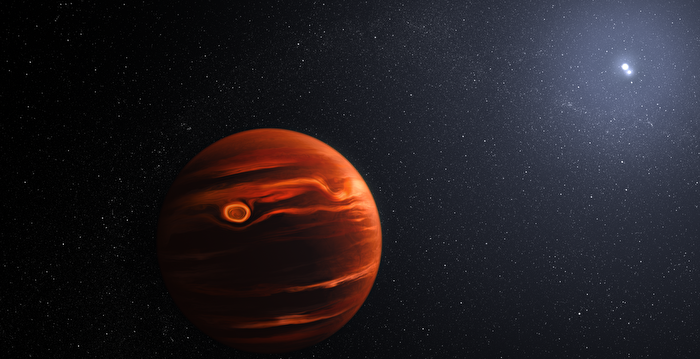This image conceptualizes the swirling clouds discovered by the James Webb Space Telescope in the atmosphere of exoplanet VHS 1256 b. (NASA, ESA, CSA, Joseph Olmsted)
[The Epoch Times, March 25, 2023](Comprehensive report by Epoch Times reporter Zhang Ting) Researchers using NASA’s James Webb Space Telescope have detected silicon in the atmosphere of a distant planet orbiting two stars. Characteristics of salt clouds.
Cataloged as VHS 1256 b, the planet is located about 40 light-years from Earth and orbits not one but two stars in a 10,000-year cycle. “VHS 1256 b is about four times farther from its star than Pluto is from our sun, making it a good target for Webb,” Myers said. “This means that the planet’s light is not mixing with the light from its star.”
Higher in its atmosphere, where the silicate clouds are churning, temperatures top 1,500 degrees Fahrenheit (830 degrees Celsius).
Within these clouds, Webb detected both larger and smaller silicate dust grains, which show up on the spectrum.
“The finer silicate particles in the atmosphere may be more like the tiny particles in smog,” said co-author Beth Biller of the University of Edinburgh in Scotland. “Larger particles are probably more like very hot, very small grains of sand.”
The atmosphere is constantly rising, mixing and moving throughout the 22 hours of the day, bringing hotter material up and cooler material down. The resulting brightness changes are so dramatic that it is the most variable planetary-mass object ever known.
The research team, led by Brittany Miles of the University of Arizona, also used Webb’s data to detect water, methane and carbon monoxide very clearly, and found evidence for carbon dioxide. This is by far the largest number of molecules discovered simultaneously on a planet outside our solar system.
Compared with more massive brown dwarfs, VHS 1256 b’s lower gravity means its silicate clouds can emerge and remain high in the atmosphere that Webb can detect. Astronomically speaking, it is quite young. Only 150 million years have passed since it formed – and it will continue to change and cool for billions of years.
What will this planet look like in billions of years? Because it is so far from its star, it gets cooler over time and its skies may transition from cloudy to clear.
Responsible editor: Lin Yan
